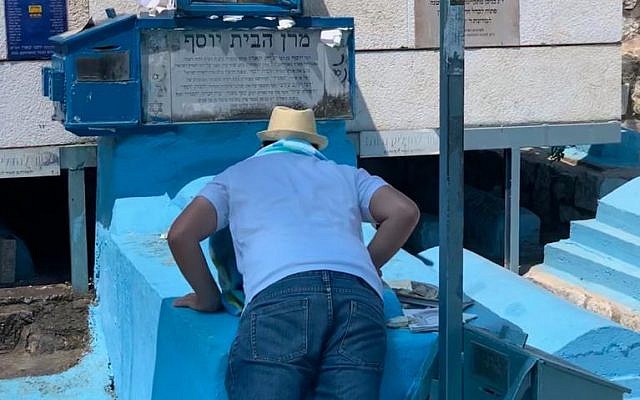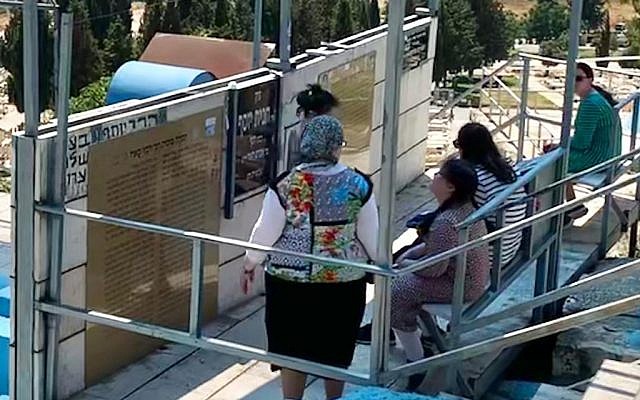
If a picture speaks a thousand words, these images scream volumes. Taken a few weeks ago in the ancient cemetery of Tsfat, they show two sides of the same grave. Rav Yosef Caro zt”l was a mystic, and the author of the Shulchan Aruch, among other works. Thousands come to pray at his graveside. Some have total access to the monument. They can touch it, kiss it, cry on it. Others can talk to the wall behind it.

I cannot think of a better pair of images to illustrate the state of Orthodoxy today, where there is one open accessed reality for men, and one increasingly restrictive reality for women.
You see, today, in Orthodoxy, a man can:
- seduce a woman to leave her husband by claiming that his is the soul of King David and hers of Batsheva. He can promise to marry her upon the (according to him) imminent death of his wife, and still maintain his position, prestige, and influence as head of a yeshiva, having been granted forgiveness by a religious court of his peers (Rav Shmuel Tal). Some brave souls speak out, but they go unheeded.
- be convicted of sex offenses, spend time in jail for them, and still be revered by thousands of followers and honored with the lighting of a torch at a government sponsored event (Rabbi Eliezer Berland).
- confess to having touched students inappropriately (and gone beyond that too), and still teach at prestigious yeshivot, and be defended by some leading rabbis in the community (Rav Motti Elon).
- protect and defend sex offenders, strong-arm professionals to lie about the mental health of accused abusers, stymie investigations into abuse allegations, and work towards the early release of predators and still serve as (deputy) health minister in the Israeli government (Rabbi Yaakov Litzman).
- be accused of molestation and rape for decades, preying on the weakest in the community, threaten victims and their families and still be honored and respected as the chief rabbi of Ukraine (Rabbi Yaakov Bleich).
And a woman can:
- have her motivations questioned and her learning belittled, even while her opportunities to learn are more numerous than ever before.
- expect all male committees to be the ones who define her communal roles and opportunities to participate in ritual.
- be increasingly shut out of holy spaces. The Kotel, Kever Rachel, the ancient cemetery of Tsfat, and more holy sites have smaller and inferior women’s spaces.
- be required to give up her rights, dignity, and possessions in exchange for freedom, in the event that her husband refuses her a divorce.
- hear from rabbis in positions of authority that spousal abuse is not grounds for divorce.
- see no images of women, even at an all-women conference.
And she cannot:
- use her own face to advertise her business.
- see images of other women like her in advertisements or publications.
- read an Orthodox publication that uses the correct words for BREAST CANCER or discusses what it may look and feel like.
- Participate alongside men in setting policy for communal issues.
- influence the determination and execution of policies that affect her.
Should she seek to change these policies, and ask:
- for women to be included in conversations and decisions that affect them…
- to have a headshot in her bio…
- to have a seat in shul where she can see and hear…
…she can expect to be called a “feminist with an agenda.”
Why are God fearing, religious women being increasingly shut out? Why are our motivations constantly and consistently questioned?
Why are the things that mean so much to us, walled off from us? And who gave the wall- builders that right?
Why is male access guaranteed, while female access shrinks?
The contrast between the way that the Orthodox community in general treats men with the way it treats women has never been stronger. Time and again, we see that men are “innocent until proven guilty.” It might be more accurate to say “innocent even when proven guilty.”
Yet for women, it is almost the opposite: women are “presumed guilty until proven innocent.” Even the wish to dance with a Torah scroll on Simchat Torah is considered subversive unless it can be “proven” to come from a pure, spiritual place.
Once we stood at Sinai together, men and women, “like one person with one heart.” Today, the heart of Orthodoxy is broken, splintered into a dangerous and gaping divide.